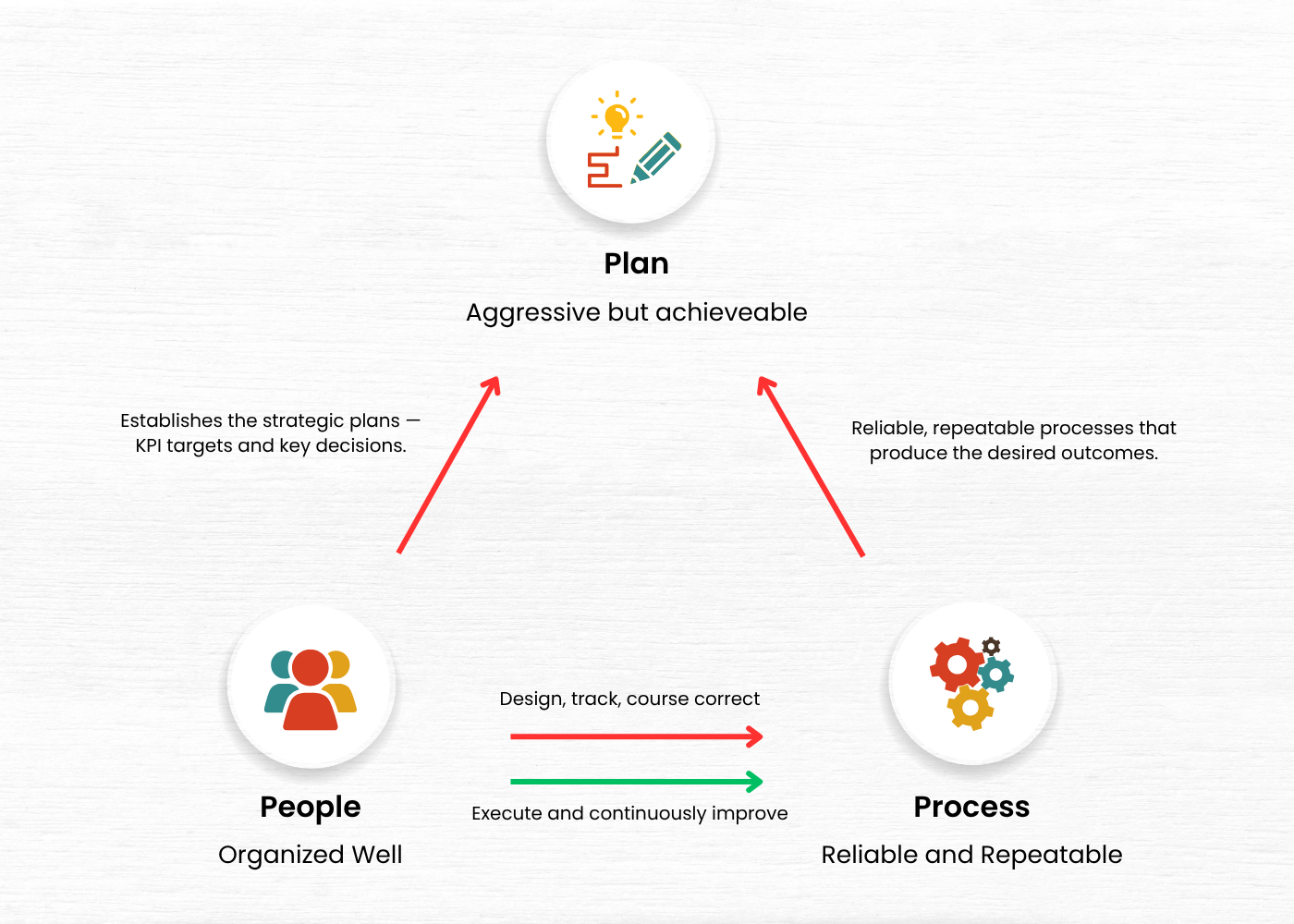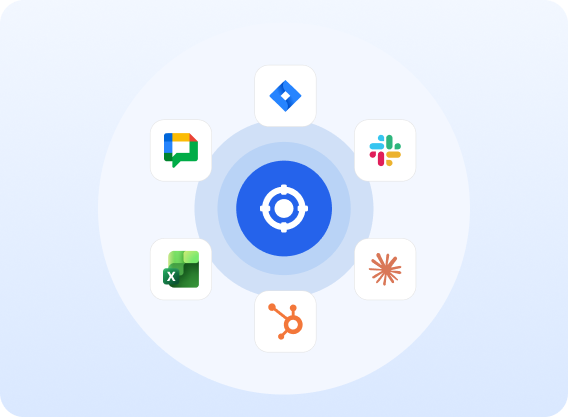Performance isn’t something that HR alone does anymore. Healthy and high-performing businesses work as a cohesive unit. And systems designed only to track employee data can’t measure how well the organization is doing
TL;DR
HRIS systems focus on storing data, not driving performance. Real progress happens when your plans, processes, and people work together in one connected system. When they’re split across different tools, alignment breaks and performance lose momentum. If your plans, people, and processes are all in different tools, your alignment will always be behind your ambition.Why do high-performance businesses need more than HRIS systems?
HRIS systems are excellent at handling things like payroll, onboarding, and compliance. But doing a worthwhile job isn’t a job for the administration. The problem starts when businesses assume that this will automatically improve business performance.What outdated HRIS systems can’t do:
- Link goals to real business KPIs
- Keep an eye on how things are going with active projects
- Give context for making decisions or coaching in real time
When a business’s plans, processes, and people work together to get things done, we see consistent progress. When these three are in separate tools, or even worse, in a system that only stores data, performance slows down.
Plans become less clear. Goals are kept in spreadsheets or static dashboards, where they don’t connect to daily work. Teams can’t see how what they’re doing fits in with the company’s goals. Processes break up. Leaders can’t see progress or make changes on time because projects and initiatives are run in different tools. People stop being interested. Employees feel like their work doesn’t matter when they can’t see their goals or get feedback right away.
This is why HRIS systems alone can’t help businesses that want to do well anymore. While HRIS systems record events, they do not assist businesses in maintaining alignment, flexibility, or responsibility.
Companies that do well need a performance system that combines plans, processes, and people into one stream of work. When these things work together, people stay motivated, strategy stays clear, and execution stays on track. That’s what makes performance management stay ahead of the curve and give businesses an edge.
What is the cost of HRIS-Centric performance for businesses?
When performance is stored in HR systems instead of being part of the business flow, the costs that aren’t obvious add up quickly. It’s not just about missing reviews or having to fill out forms that don’t work right. It’s also about losing alignment, slowing down work, and wasting potential all over the company.Let’s take a look at it:
1. Plans Don’t Work Anymore
When strategic goals are kept in slides or static systems, they quickly lose their value. While the business moves on, teams keep working on old priorities. What does it cost?- Putting in too much work on projects that don’t matter
- Execution on strategic priorities has been delayed
- Missed chances to make money because resources weren’t used where they were most needed
- Unconnected planning processes slow down teams and prevent them from progressing
2. Things go wrong with processes
Leaders can’t see what’s going on when processes are spread out over different tools. They spend time in status meetings putting together updates instead of guiding execution. How much does it cost?- Hours wasted on tracking and reporting by hand
- Making decisions late because there isn’t any real-time data
- Workflows that aren’t efficient and slow down speed to market
- Broken processes make things harder to run, slowing down what should be a sprint.
3. People lose interest
When workers don’t understand how their work helps the company succeed, they lose motivation. Performance reviews don’t feel like routine admin. What is the cost?- Less engagement and productivity
- More turnover among top performers
- Costs of rehiring and retraining are going up
4. Not Being on the Same Page and Not Growing
When plans, processes, and people don’t work together, the business loses time, effort, and performance that could have been better. Instead of leading, leaders end up reacting. They need a system that keeps plans visible, processes efficient, and people interested. That’s what really drives performance and growth that can be sustained.Integration is the first step in that change. When your plans, processes, and people all work together in one system, you can see, measure, and change how well things are going.
“Great things in business are never done by one person . They’re done by a team of people.”
Why do disconnected systems make alignment impossible?
Most businesses use more than one system. For example, HR keeps track of performance reviews. Operations is in charge of projects. KPIs are tracked by finance. Marketing runs campaigns on its own platform. Each system has important information, but they don’t talk to each other. That means leaders make choices based on only some of the facts. Managers go after progress that they can’t see. And workers lose sight of what’s really important. This won’t be fixed by adding another dashboard. Integrating all in one platform can solve al the above problems. Move beyond HRIS limits and build a connected, high-performing organization. Click here.How to move from price to capability?
Disconnected performance costs every business in terms of lost focus, slower execution, and teams that aren’t engaged. But those costs won’t last forever. The good news is that when performance moves out of HR systems and into the business itself, alignment, clarity, and momentum can all be rebuilt. This is the basis of the Performance Triangle, which is a model that connects what a company wants to do, how it gets done, and who is responsible for making it happen.How does the Performance Triangle address this challenge for you?
When plans, processes, and people work together in one system, performance stops being a cycle of forms and reviews and starts to be an ongoing rhythm of doing things. Companies need to stop worrying about how to run their HRIS and start worrying about how to make it work with other systems
You need the Performance Triangle. It brings together Plans, Processes, and People into one system that makes strategy work
1. Plans: Find out the “What” and the “Why”
Plans are more than just goals; they are promises to do what you say you will do. They talk about where the business is going and why it matters. When plans are stored in an integrated performance system, everyone can see them, make sure their work is in line with them, and see how things are going in real time.2. Processes: Make the “How”
Processes, encompassing projects, initiatives, and workflows, bring plans to life. They are the engine that drives the plan. Integrated processes make sure that things stay the same and can grow. This means that performance depends on process design as well.3. People—Drive the “Who”
People do things, think of new ideas, and follow through. But they can only do their jobs if they are part of the plan and have good processes in place. When employees can see all of their goals, projects, and feedback in one place, they know how their work helps the company succeed, and leaders can see the effect right away.Plans, processes, and people all work together to make a loop that keeps going. Plans help you know where you’re going. Processes help you get things done. People make it real. When these three things work together, they naturally come into alignment. Teams know where they’re going, leaders can see the work being done, and performance can be measured, changed, and done again. The real change is going from recording work to driving results, which is what integrated performance is all about.
How to Get Past the traditional HRIS Way of Thinking
Every company should ask this question: “Where does performance really reflect?” It’s time to think again if your answer is “in an annual review form.” Every day, performance happens in meetings, projects, and interactions with customers. It should be part of the workflow, not stuck in HR systems.- Put performance into the tools and spaces your teams already use
- Put goals directly in touch with projects that are already going on.
- Link projects to results that can be measured.
- Link recognition to real outcomes.
Uniting your plans, processes, and people can turn performance into real business momentum.
Because HRIS systems were built to store employee data, not manage performance. They handle payroll, onboarding, and compliance well, but they can’t track how work connects to goals or how people actually perform day to day. They tell you what happened, not how to improve.
HR sets the structure and tools, but leaders, managers, and employees drive it through daily work, feedback, and alignment.
Integration establishes connections between various aspects of the business. When plans, processes, and people live in the same system, everyone sees the same truth. Feedback gets faster, priorities stay clear, and decisions happen with real context. It replaces silos with flow.
Things slow down. Plans lose relevance, leaders chase updates, and employees feel disconnected from what matters. Over time, engagement drops and execution drags. It’s like running today’s business on yesterday’s tools.
It brings everything together.
Related Articles
-
How to Manage Agile and Waterfall Projects Together with Unified Project Portfolio Management
Karthick Nethaji Kaleeswaran Director of Products | Strategy Consultant Organizations rapidly shifted toward Agile methodologies, often abandoning Waterfall in the... Read more
-
12 Common Say-Do Ratio Pitfalls and How to Fix Them for Better Execution
Your Say–Do ratio shows how well your team delivers on promises. Most teams have problems not because they aren't good... Read more
-
How the Say-Do Ratio Helps Measure Commitment in Agile Teams
Agile teams live on a steady diet of promises and proof. At sprint planning the promise is made, and at... Read more
-
How Does Your Say–Do Ratio Change Across Different Work Environments?
We've all worked with that person. On Tuesday, they promise to look over your proposal by the end of the... Read more




